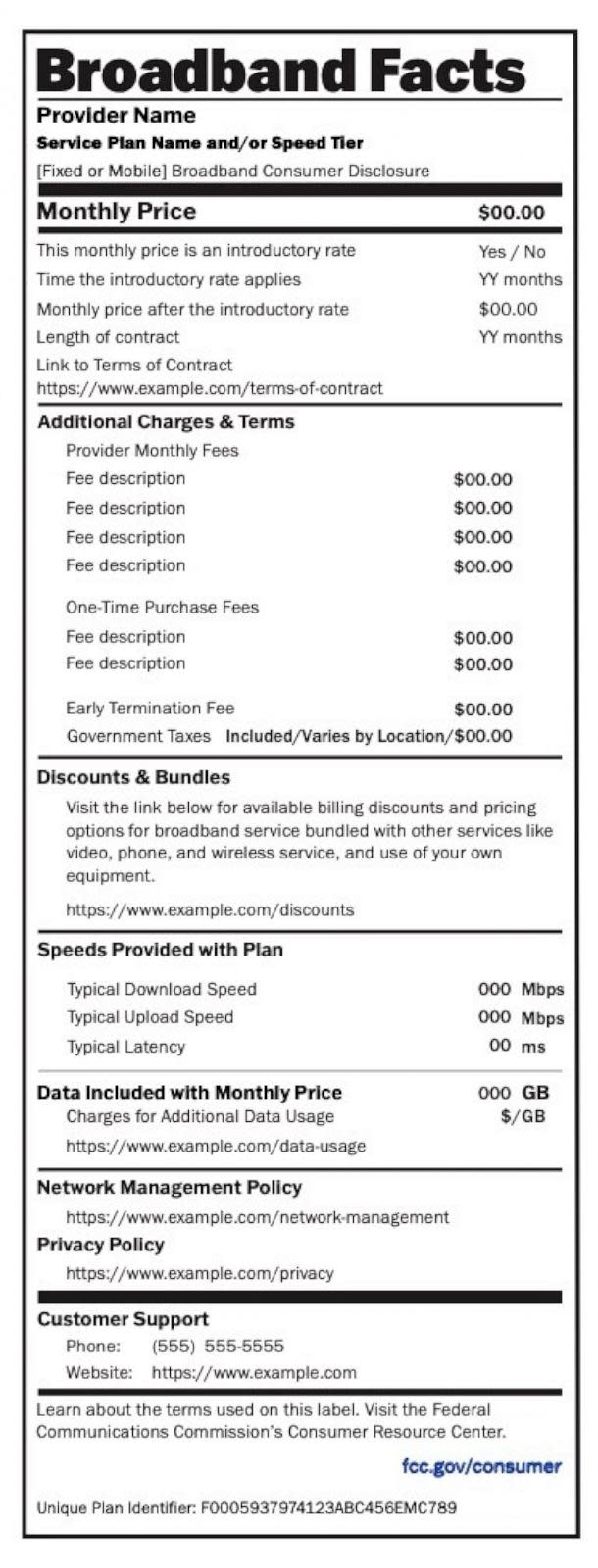Starting Wednesday, internet users will now have more transparency about their broadband services.
The Federal Communications Commission now requires broadband providers to display in clear labels all information about the price and performance of their services.
Alejandro Roark, chief of the FCC’s consumer and government affairs bureau, spoke about the new rule on ABC News’ “Start Here.”

START HERE: What should we know about this announcement today?
ALEJANDRO ROARK: Good morning, Brad. I’m so happy to be here today. And I think the important thing to recognize is that bipartisan infrastructure legislation, [and] Under this law Congress directed the FCC to [a] The broadband provider displays specific and important information in the form of labels regarding the price and performance of the internet service plan.
So whether you are shopping online or on your mobile phone, wherever there is a point of sale, [or] These need to be clearly visible to all consumers, whether you’re in store.
So it shouldn’t be confusing, hiding behind some special five clicks you need to get to or making it difficult to find that information. The rules require these labels to be available at the point of sale, where we comparison shop and prepare to make the choice that best meets our household needs and long-term budgets.
MORE: Video Proposed reinstatement of net neutrality rules
START HERE: What will this label do and what will it look like?
ROARK: I think the FCC was wise to borrow the nutrition label model format from food products because we wanted this basic information to be easily recognizable and easy to understand.
START HERE: To be clear, it literally looks like the label with the same formatting, shape, and other stuff.
ROARK: Absolutely. So, starting today, consumers will have simple, easy-to-read facts about price, speed, data allocations and other aspects of high-speed internet service up front.
Additionally, by requiring providers to clearly display their introductory rates, we aim to end unexpected one-off or hidden recurring charges or other unnecessary fees that are often hidden in long and confusing terms and conditions statements. I definitely felt the consumer bill shock when I signed up for what must have been a really great deal and then received my first month of service [bill] and the prices are completely different.


START HERE: Oh, okay, okay. It’s literally like a food nutrition label, but it’s going to be a broadband nutrition label. When will this come into force?
ROARK: Okay, Brad, breaking news is happening on this podcast. That’s why I’m happy to say that from today, April 10, 2024, broadband providers must display these new broadband nutrition labels at the point of purchase. And we’ll all start seeing these wherever internet services are sold.
START HERE: Is it all just design? Is it just kitsch, or do you think it will have a serious impact? I guess I wonder how big of a problem this is for many people in real life.
ROARK: From my perspective, it’s a kind of marketplace, a transformative ecosystem tool.
I think what we know at this point after the global health crisis is that access to high-quality internet service is crucial to maintaining important aspects of our daily lives. I’m talking about telemedicine. I’m talking about educational opportunities for students, and I’m talking about our ability to interact with the world and seek government services — .
Think of all the core services that moved entirely online overnight, and you’ll see that none of those processes, systems, or support services are coming back in person. They stay online. And this has forced us all to confront the fact that the Internet is an indispensable tool for 21st century success.


START HERE: But here’s what I’m wondering; If this is all about making the internet more accessible, making everything transparent, and making it easier for consumers across the country to get online, there are also programs designed to help low-income earners. Americans have access to broadband internet. I think it’s something like $30 a month.
Funding for this program will run out at the end of this month, and I’m sure the FCC will say: “Yes, we would like Congress to legislate on this.” Fees from broadband companies will be paid into a pot. I think that kind of lifeline for these communities is the Universal Service Fund. So will the FCC do this?
ROARK: So I will say that this particular program, the Emergency Broadband Assistance program, which is a COVID emergency response program, is really designed to make sure that every single person, regardless of their zip code or economic status, has the opportunity to sign up. For the internet service they need.
Again just for basic engagement. Since then, over the past two years, the Affordable Connectivity Program has done more to close our nation’s digital opportunity gap than any other independent effort in the nation’s history.
Currently, the program counts more than 23 million households enrolled in all 50 states, territories, and federally recognized tribal lands, and the success, scope, and impact of the program are simply indisputable.
But as you noted, we know that without congressional action to provide new funding for the program, the Affordable Connectivity Program will run out of funding by the end of April, leaving potentially millions of households without the internet connections we all depend on. Open.
Currently, Congress is considering how best to provide long-term, sustainable funding for the program. But at the same time, I think right now they’re also thinking, what are we going to do in the meantime? April, the end of April, is just around the corner.
MORE: Biden announces expansion of discounted internet program for low-income households
START HERE: Like, why not legislate some of these fees onto broadband providers, I guess?
ROARK: Yes. And I think all of this is still being negotiated. The Universal Utility Program is something that I think has been around for a long time, and there’s a lot of discussion and conversation about: Can we adapt this program to meet the funding needs of the Affordable Connectivity Program?
And that’s something Congress is discussing with consumer advocates right now, and we’re at the table to make sure that whatever comes out of this process meets American consumers where they are. We know that 23 million households are currently enrolled and many more remain eligible to enroll in this program.
[
]
The web service now comes with ‘nutrition label’ style information on prices that originally appeared on abcnews.go.com